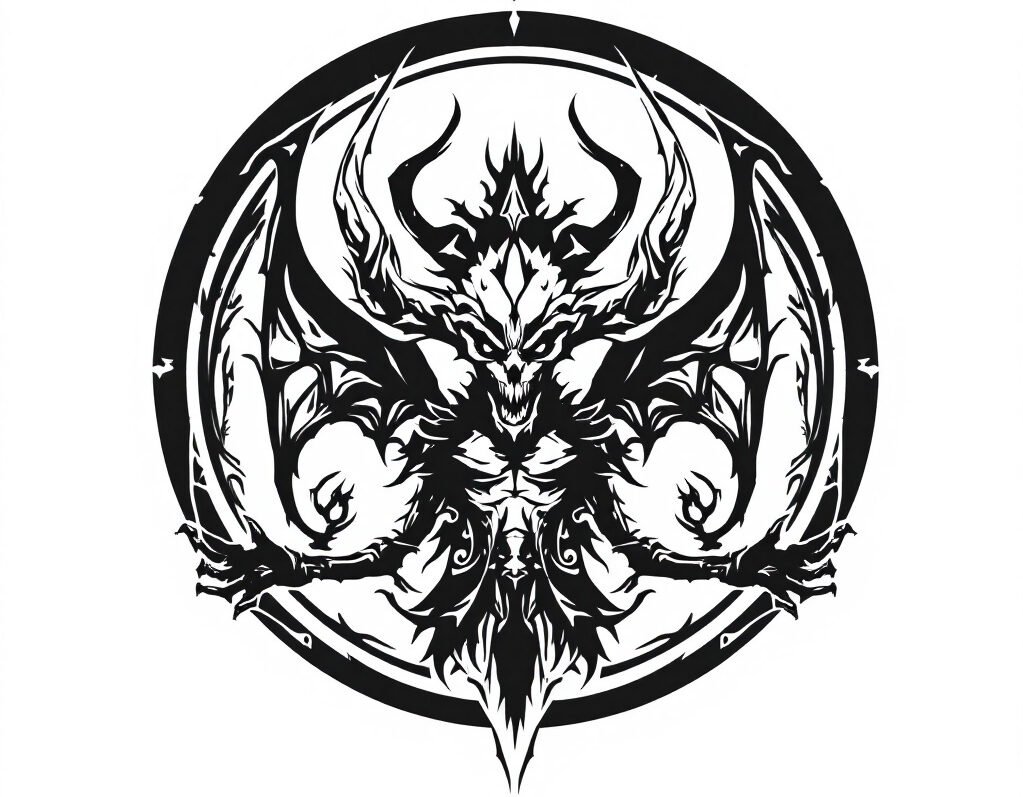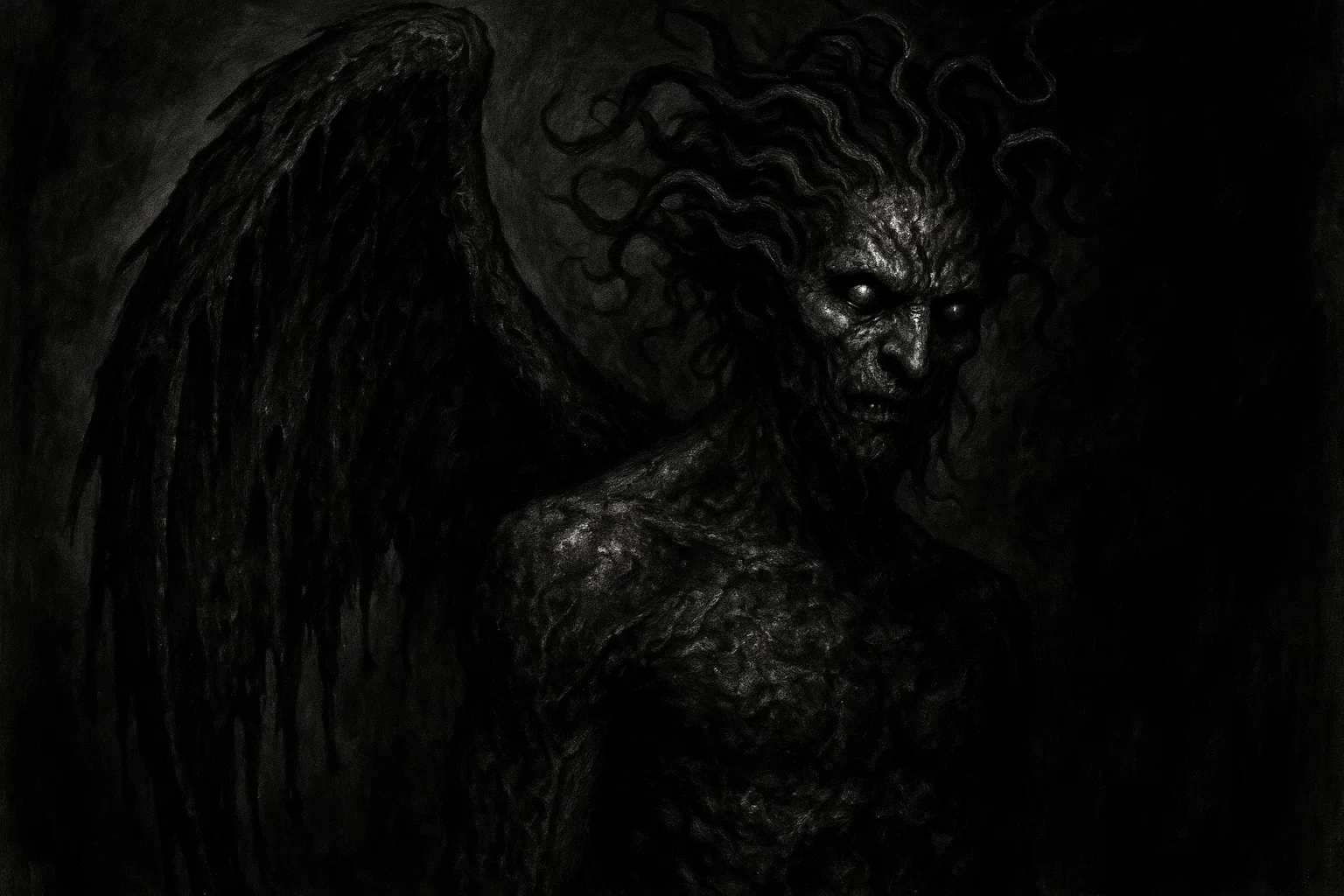Abezethibou is a powerful demonic entity in ancient demon lore. A fallen angel turned demon, known for his rebellion against divine order and his role in several significant biblical events. In Jewish and Christian texts, this demon is portrayed as a one-winged monster, marked by his defiance during the War in Heaven.
Once a heavenly being, Abezethibou sided with Beelzebub and was thrown into the depths of Hell. He is a cunning force that stirs chaos among humans and opposes prophets like Moses.
Summary
Key Takeaways
| Attribute | Details |
|---|---|
| Names | Abezethibou, Abezethibod, Abezi-Thibod, Abez, Abezi |
| Title | Prince of Hell, Demon of the Red Sea, Warden of Tartarus, Spirit of Hardened Hearts |
| Gender | Male |
| Role | Tempter who hardens hearts against divine will; provider of forbidden magic to oppose prophets; controller of imprisoned souls in the abyss; inciter of pursuit and destruction |
| Hierarchy | Prince under the Seven Princes of Hell; advisor and strategist to Beelzebub; member of the Stygian Council |
| Servitors | Twelve lesser demons (eight named: unspecified in primary texts) |
| Superior Demon | Beelzebub (father and lord) |
| Powers | Performs signs, wonders, and miracles superior to human prophets; grants magical abilities to summoners; manipulates thoughts to lead astray; controls winds over the Red Sea; hardens hearts to foster rebellion and cruelty |
| Appearance | One red wing (torn from the other during fall); charred, mutated skin; angelic form twisted into demonic shape with blood-red remnants |
| Etymology | Hebrew origins, possibly “Father Devoid of Council,” implying foolish rebellion or separation from wisdom |
| Associated Figures | Beelzebub (father); Ephippas (ally in release); Jannes and Jambres (summoners); Moses (adversary); Pharaoh (influenced victim); Ornias, Asmodeus (fellow demons in Solomon’s bindings) |
| Weaknesses | Bound by divine rings and names like those on Solomon’s seal; trapped by holy waters and pillars; repelled by archangels like Michael and Azrael; frustrated by prayers invoking God’s authority |
| Opposing Angel/Saint | Archangel Michael (bestower of binding ring); Archangel Azrael (drowner in Red Sea); Archangel Uriel (ruler of Tartarus in some lore) |
| Pantheon | Judaic-Christian, with Egyptian influences from Exodus events |
| Legions | None (focuses on personal dominion over Tartarus souls rather than commanding legions) |
| Element | Water (imprisoned in Red Sea; controls sea winds) |
| Planet/Zodiac | Mars/Pluto; Scorpio (intensity, transformation, depths of psyche) |
| Color(s) | Blood red (wing and fury); black (shadowy form) |
| Number(s) | 12 (servitors); 7 (under Seven Princes) |
| Crystal(s)/Mineral(s) | None specified; modern occult links to obsidian (for abyss gazing) or red jasper (blood ties) |
| Primary Sources | Testament of Solomon (pseudepigrapha); Old Testament Pseudepigrapha (Charlesworth ed.); Dictionnaire Infernal (Collin de Plancy); Encyclopedia of Demons and Demonology (Guiley); Black Witch Coven grimoires |
“Abezethibou” Meaning
The meaning of the name “Abezethibou” is linked to rebellion and lost wisdom. The name “Abezethibou” likely derives from elements such as “Abeze” (which suggests a paternal or foundational force) combined with “Thibou” (evoking separation or emptiness). One key interpretation renders it as “Father Devoid of Council,” a phrase that captures the folly of defying divine guidance.
This Abezethibou definition points to a being stripped of heavenly counsel, forever adrift in prideful isolation. In linguistic terms, the name’s harsh consonants—ab-ez-eth-i-bou—mimic the tearing of wings, a phonetic nod to his violent fall. Scholars trace this to Semitic roots where names often encode moral lessons, with Abezethibou serving as a warning against forsaking wise advice.
Etymology traces “Abezethibou” to Semitic origins, possibly blending “ab” (father) with “zeth” (devoid or without) and “ibou” (counsel or assembly), reflecting Jewish views of fallen entities as counsel-rejecters.
Interestingly, historical evolutions show variations across texts: in Greek pseudepigrapha (such as the Testament of Solomon), it appears as “Abezi,” a shortened form for “invocation.” Latin grimoires adapt it to “Abezethibod,” adding a bodily suffix to stress his mutated form.
Symbolic interpretations deepen the Abezethibou’s meaning, linking it to moral corruption through separation from wisdom. As “Father Devoid of Council,” he embodies the sin of pride that severs ties to God, much like the Pharaoh’s stiffened resolve.
In Christian traditions, this evolves into a warning against hubris, with the name’s void implying an empty throne in Hell—power without purpose.
How to Pronounce “Abezethibou” in English
To say Abezethibou in English, break it into syllables: Ah-bez-eth-ih-boo. Stress falls on the third syllable, “eth,” making it ah-BEZ-eth-ih-boo. The “A” sounds like the “a” in “father,” “bez” rhymes with “fez,” “eth” like “beth” but with a soft “th,” “ih” as in “bit,” and “boo” like the ghost sound.
Some variations say it as Ah-buh-zee-thih-bow, but the standard keeps the hard “z” and flowing vowels.
What Does Abezethibou Look Like?
Abezethibou is depicted as a strikingly unbalanced figure, blending angelic remnants with demonic traits. In the Testament of Solomon, he appears as a one-winged being, his blood-red wing torn from him during his fall from heaven, leaving behind charred, mutated skin. This asymmetrical form—half-celestial and half-demonic—casts a shadow between beauty and horror.
His face is described as greenish with disheveled hair that resembles serpents, reflecting envy and entrapment. Cloaked in darkness, he symbolizes his control over Tartarus’s prisoners. When summoned, he displays nocturnal traits, with his eyes burning with pride. Some depictions show him with insectoid limbs, while others maintain a humanoid form with the red wing dripping ichor.
Symbolically, the single wing represents incomplete rebellion and his exile in Hell. Historical illustrations often portray him in stark black and white, focusing on raw deformity. Byzantine art hints at him being chained beneath pillars, serving as a warning of beauty’s corruption and the fate that awaits those who fall from grace.
Origins
Abezethibou‘s origins can be traced back to the turbulent crossroads of ancient Near Eastern myths, where celestial rebels clash with the emerging monotheism.
Earliest mentions appear in pseudepigraphal works (such as the Testament of Solomon), a 1st- to 4th-century Greek text that blends Jewish folklore with Hellenistic magic. Here, the demon is mentioned not as a primordial chaos spawn but as a high-ranking angel from the first heaven, Amelouth, who bonds with Beelzebub during the War in Heaven.
This cataclysmic revolt (described in Isaiah 14 and Revelation 12) sees him torn mid-descent, his wing ripped by loyal seraphim—a motif drawing from Mesopotamian tales of Igigi angels defying Enki’s order.
His birth as the offspring of Beelzebub and Naamah, a succubus, adds layers, conceived to wield power against the heavenly hosts; his very existence is a tool in infernal schemes.
Egyptian mythology infuses him with Set’s chaotic essence (the demon God who slays Osiris and stirs storms), paralleling his wind control and opposition to order-bringers like Moses.
By the Hellenistic era, Abezethibou integrates into Solomonic magic, his name Hellenized to evoke abyssos (abyss), linking him to Greek Tartarus as soul-warden. His role as a devourer of angelic Aether during battles echoes Babylonian myths of gods consuming their enemies to gain strength.
Origen (one of the early Church Fathers) hints in his work Contra Celsum at powerful entities called the “fallen watchers”, grouping Abezethibou and others with the Grigori, who corrupt humanity through forbidden arts—much like their aid to Jannes and Jambres. Medieval grimoires, such as the Grand Grimoire, elevate him to Hell’s strategist, advisor to Beelzebub amid the Seven Princes’ court.
In Pseudomonarchia Daemonum (1577), Johann Weyer classifies him loosely under the category of gluttony princes, tying his hunger for Tartarus souls to Beelzebub’s fly-swarm. This evolution reflects Christianity’s assimilation: Jewish exodus adversary becomes universal tempter, his prison a baptismal inversion.
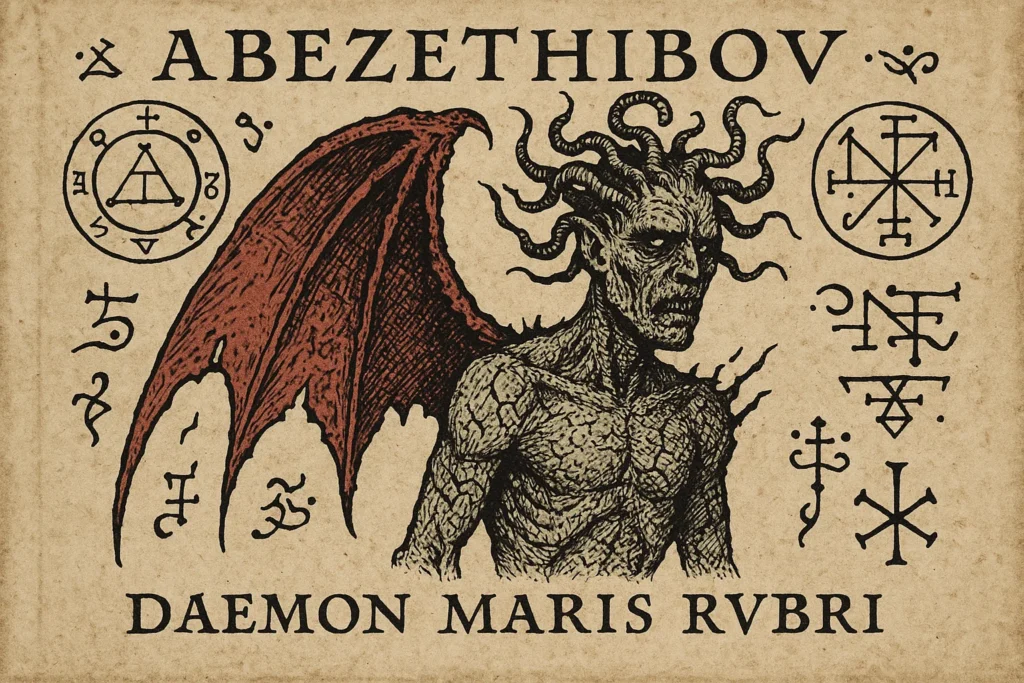
Was Abezethibou Ever Mentioned in the Bible?
Abezethibou is not mentioned directly in the canonical Bible, neither in the Old Testament’s Exodus narrative nor in the New Testament’s apocalyptic visions. The Book of Exodus attributes the Pharaoh’s hardened heart to God’s will (e.g., Exodus 7:3, 9:12), not to a demonic agent, and the magicians Jannes and Jambres appear unnamed until 2 Timothy 3:8, where they are referred to as false workers.
You may also enjoy:
Who Is Aka Manto, Japan’s Terrifying Red-Cloaked Yōkai?
October 24, 2025
Mara: The Buddhist Demon King of Desire and Death
October 13, 2025
Abura-akago: The Oil-Licking Demon Baby
October 22, 2025
Who Is Adrammelech in Demonology and the Bible?
October 1, 2025
Arati: The Beautiful Demon of Aversion in Buddhist Mythology
October 15, 2025
Rāga: The Seductive Demon of Passion and Desire in Buddhist Lore
October 16, 2025
Abezethibou in Grimoires and Other Texts
While not directly mentioned in the Bible, Abezethibou appears in occult compendia, where Solomonic bindings and infernal hierarchies amplify his menace.
For example, Collin de Plancy’s Dictionnaire Infernal (1818) mentions him as a Red Sea plotter against winds, syncretic with Kabbalistic watchers.
Another good example is The Grand Grimoire (a 19th-century French text), where Abezethibou is a master of demonic pacts, and summoners invoke his magic for wonders.
| Source | Quote |
|---|---|
| Testament of Solomon (Beelzebub’s confession) | And the other engine, which I have, is Abezethibou, who accompanied me from the beginning. He it is who is in the Red Sea, drowned with the Egyptians. And he will come up in conquest against the body of Christ, when he is ready. |
| Testament of Solomon (Abezethibou‘s speech) | I am Abezethibou, and I sit in the first heaven, which is called Amelouth. I was sent to oppose Moses in the signs wrought by him. I hardened Pharaoh’s heart. I am he who fought against thee, O Solomon, with signs and wonders. |
| Dictionnaire Infernal (Collin de Plancy) | Abezethibou, one-winged demon of the Red Sea, plots against every wind under the heavens, and is the enemy of Moses. |
| Encyclopedia of Demons and Demonology (Guiley) | Abezethibou takes credit for turning the pharaoh against Egypt and for inciting the Egyptians to pursue the Israelites in their exodus. |
| Encyclopedia of Demons in World Religions and Cultures (Bane) | Abezethibou, the demon of African spirits and the sin of pride; a nocturnal, one-winged demon, he commands twelve servitors. |
| Pseudomonarchia Daemonum (Weyer, indirect via Beelzebub) | Beelzebub, called also the Prince of Devils, was of the order of Seraphims, and 666,000 demons wait upon him. |
Powers and Abilities
Abezethibou wields an arsenal of dark gifts, all bent toward sowing discord and defying the divine. These stem from his angelic past, twisted into tools of temptation and ruin:
- Heart-Hardening Influence: He manipulates wills to foster stubborn cruelty, as seen in stiffening Pharaoh’s resolve against mercy.
- Bestowal of Magic and Wonders: Grants summoners signs, miracles, and sorcery surpassing prophets; aided Jannes and Jambres in Exodus duels, but was overpowered by God’s superior might.
- Leading Astray: Subtly shifts thoughts to promote pride and rebellion, drawing souls from righteousness—effective on the wavering.
- Wind and Sea Control: Commands gales over the Red Sea for storms and pursuits.
- Dominion over Tartarus Souls: Oversees imprisoned wicked in the abyss, feeding on their torment to fuel endless hunger.
- Signs and Adversarial Deeds: Performs deceptive feats to mock divine works.
Abezethibou Myths, Legends, and Stories
Abezethibou‘s tales cluster around falls, bindings, and vengeful pursuits, drawn from Solomonic pseudepigrapha and echoed in demonological compends.
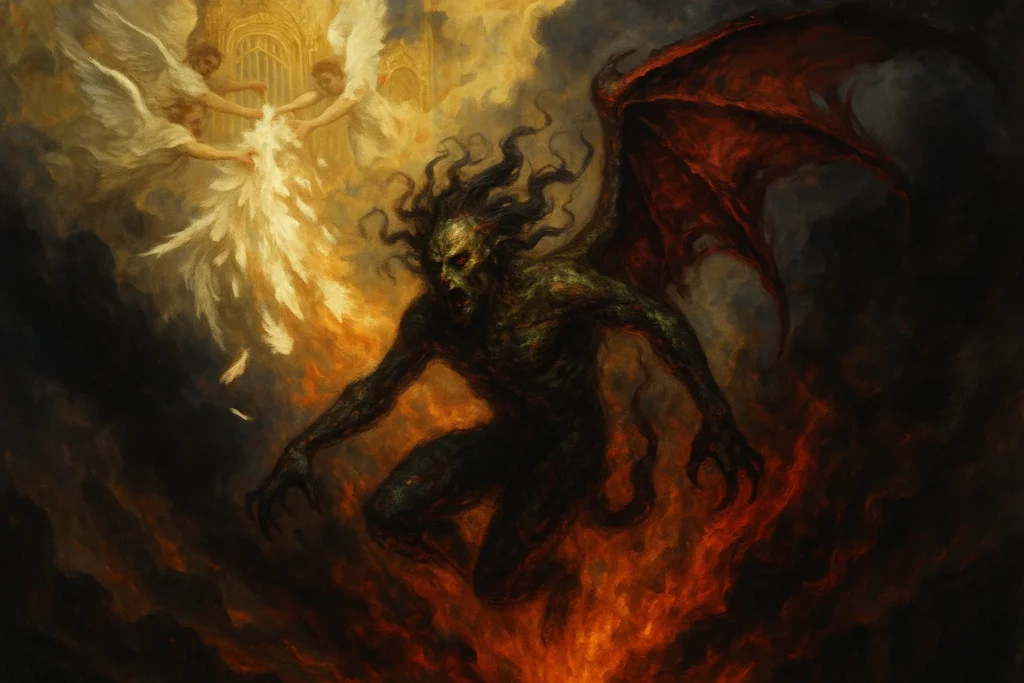
The Fall from Amelouth
Amelouth, the first heaven, was a wonderful place. There, Abezethibou was a trusted and powerful seraph, his wings pristine and his eyes always fixed on celestial glories.
However, whispers of discontent stirred when Beelzebub rallied against the Almighty’s throne. Among the traiterous angels was Abezethibou. He pledged loyalty to the infamous Lord of Flies and Envy, his heart swollen with pride at the promise of unchained rule.
As war erupted—swords of light clashing with shadows of doubt—the rebel host surged downward, heaven’s gates cracking under fury. Abezethibou fought fiercely, devouring the Aether from slain angels to increase his might, his form growing amid the chaos.
After a long battle, a group of loyal angels, led by the Archangel Michael, intercepted the deserters. They charged at Abezethibou, claws sinking into his left wing, desperate to drag him back to grace. The corrupted angel screamed and twisted until his wing tore with a shriek that echoed through the voids, feathers scattering like bloodied snow.
He plummeted, the severed limb crumbling to ash, while his right wing charred crimson from the friction of divine fire. Stripped and scarred, he crashed into infernal pits, where Beelzebub welcomed him not with pity, but with a throne in the Stygian gloom.
There, amid Hell’s wails, Abezethibou nursed grudges, vowing conquest on the wounds of Christ.
Summoning by Jannes and Jambres Against Moses
In the court of Pharaoh, two chief sorcerers named Jannes and Jambres engaged in occult practices amidst a setting filled with incense and serpentine imagery.
They confronted Moses, who arrived with a rod that transformed into a snake, challenging their magical capabilities. In response, Jannes and Jambres traced complex circles in the sand while reciting names from forbidden texts, attempting to invoke their own form of magic.
During their incantations, a demon named Abezethibou emerged from the ether, manifesting as a being of immense power. He asked the sorcerers about their intentions, and they expressed a desire for power to rival the God of the Hebrews.
Abezethibou, filled with pride and confidence in his superiority over divine figures, agreed to assist them. He augmented their magic, allowing them to transform rods into serpents, turn water into blood, and summon swarms of frogs to fortify their claims. These miraculous feats initially dazzled the court, causing Pharaoh to doubt Moses’ authority.
However, as the plagues intensified—devouring locusts and the death of the firstborn—Abezethibou’s power began to wane under the strength of Moses’ divine influence. The demon ultimately retreated, frustrated and weakened, proclaiming that the failure of Jannes and Jambres would haunt him, binding him in a cycle of insatiable desire for vengeance against the Hebrew God and his prophet.
Conflict with Angels in Egypt
During his journey through Egypt, Abezethibou encountered Dumah, the angelic guardian associated with silence and death, who was tasked with overseeing the land.
Through insidious temptations, Abezethibou managed to corrupt Dumah’s resolve, leading the angel to embrace chaos and neglect his duties. This act triggered a wave of unrest in Egypt, leading to widespread plagues and increasing discord among the population.
In response to the escalating turmoil, Azrael, the Angel of Death, intervened. Wrapped in solemn robes, he confronted Abezethibou amidst the winds of the Nile. The two engaged in a fierce clash, during which Abezethibou used storms and illusions to protect himself. However, Azrael wielded his scythe effectively, cutting through the demon’s deceptions and forcing him toward the Red Sea.
Abezethibou Faces Moses
While wandering Egypt’s sun-baked sands post-fall, Abezethibou crept under the shadows of pyramids, his red wing trailing dust like a curse. It was at the time when Moses approached the Pharaoh’s court, demanding freedom for enslaved kin.
According to the story, initially, the Pharaoh was willing to grant Moses’s request. But Abezethibou hissed in his royal ears: “Why yield to slaves?”
Under the demon’s influence, the Pharaoh changed his mind, commanding the chains to tighten. As Israelites fled under parted seas—walls of water held by Moses’ plea—Abezethibou spurred the chase, winds whipped by his fury to hasten chariots. He rode the vanguard, whispering valor to soldiers, promising glory in recapture.
But when the army plunged into the gap in the sea, the divine wrath descended upon them and the fallen angel. Waters crashed, engulfing Egyptians in froth and screams.
Drowned yet undying, Abezethibou clawed at the prison, vowing to return when stars aligned for vengeance.
You may also enjoy:
Mara: The Buddhist Demon King of Desire and Death
October 13, 2025
Who Is Jann in Islamic Mythology and Why Is He Feared?
October 2, 2025
Who Is Aka Manto, Japan’s Terrifying Red-Cloaked Yōkai?
October 24, 2025
Mahakala: The Dark Guardian Who Consumes Evil
October 16, 2025
Who Was Mahishasura, the Buffalo Demon Slain by Goddess Durga?
October 3, 2025
The Ghul: The Flesh-Eating Demon of Arabian Folklore
October 1, 2025
Abezethibou vs Other Similar Demonic Entities
| Demon Name | Associated Sin/Temptation | Rank/Origin | Key Traits/Powers |
|---|---|---|---|
| Asmodeus | Lust and wrath | King; Book of Tobit, Ars Goetia | Commands 72 legions; slays husbands, induces rage; bound by fish gall and prayers |
| Belial | Lawlessness and worthlessness | Prince; Dead Sea Scrolls, Testament of Solomon | Deceitful advisor; corrupts leaders; invisible influences, repelled by divine names |
| Lilith | Envy and infant mortality | Night hag; Jewish folklore, Alphabet of Ben Sira | Strangles newborns; shape-shifts to seductress; warded by amulets and angels |
| Ahriman | Pride and destruction | Supreme evil; Zoroastrian Avesta | Opposes light; spreads lies and decay; countered by Ahura Mazda’s fire |
| Mastema | Testing faith through trials | Prince of evil; Book of Jubilees | Incites sin in elect; requests demon hordes; limited by God’s mercy post-flood |
| Samael | Poison of God, accusation | Accuser; Talmud, Apocalypse of Moses | Venomous tempter; rides serpent; blinded by holy oil in some rites |
| Azazel | Rebellion and scapegoating | Fallen watcher; Leviticus, Book of Enoch | Teaches forbidden weapons; exiled to desert; atoned via Yom Kippur rites |
| Pazuzu | Winds and plague | King of winds; Mesopotamian exorcism tablets | Brings famine storms; protects against kin; clay figurines repel his gales |
| Abaddon | Destruction and locusts | Angel of abyss; Revelation 9 | Unleashes plagues; bottomless pit lord; sealed by trumpets’ woe |
| Ornias | Theft and vitality drain | Vampire spirit; Testament of Solomon | Sucks life via thumbs; shape-shifts; bound by Solomon’s ring to labor |
| Ephippas | Desert tempests | Wind demon; Testament of Solomon | Raises pillars; aids pursuits; yoked eternally to abyssal kin |
| Abyzou | Miscarriages from envy | Infertile hag; Late antique amulets | Causes child loss; legless wanderer; iron rings and chants dismiss her |
| Agrat bat Mahlat | Seduction and magic | Succubus queen; Jewish demonology | Rules Lilith’s dance; spreads illness; midnight flights halted by rooster crows |
| Naamah | Fornication and music | Seductress; Genesis midrash | Lures with harps; forges metals; averted by Sabbath lamps |
| Obyzuth | Strangling newborns | Child-killer; Testament of Solomon | Legless, wild-haired; envies mothers; Solomon’s chain binds her wildness |
Rank in the Hierarchy of Hell
Abezethibou holds an ambiguous position within the hierarchy of Hell, serving as a prince among the Seven Princes and directly under the influence of Beelzebub. Unlike the dukes of Goetia, Abezethibou does not command legions of demons but instead oversees the numerous damned souls in Hell.
As a master strategist, Abezethibou participates in the councils of Hell, where he advises powerful figures, including Lucifer. His parentage, being the offspring of Beelzebub and the demoness Naamah, grants him a seat at the Stygian Council, making him an influential advisor on matters of invasion and corruption.
The dynamics of his relationships are crucial to his status. His connection to Beelzebub creates a complex alliance, while his own transformation towards insectoid characteristics reflects his challenges and internal struggles.
In terms of comparative power, Abezethibou’s influence lags behind that of Lucifer, yet is superior to lesser shades like Ornias, whom Solomon first bound. His substantial influence allows him control over fallen watchers, and he demands tribute from the Grigori. He has formed alliances with creatures of the wind, such as Ephippas, while simultaneously planning strategies against Michael’s host, who have inflicted wounds upon him.
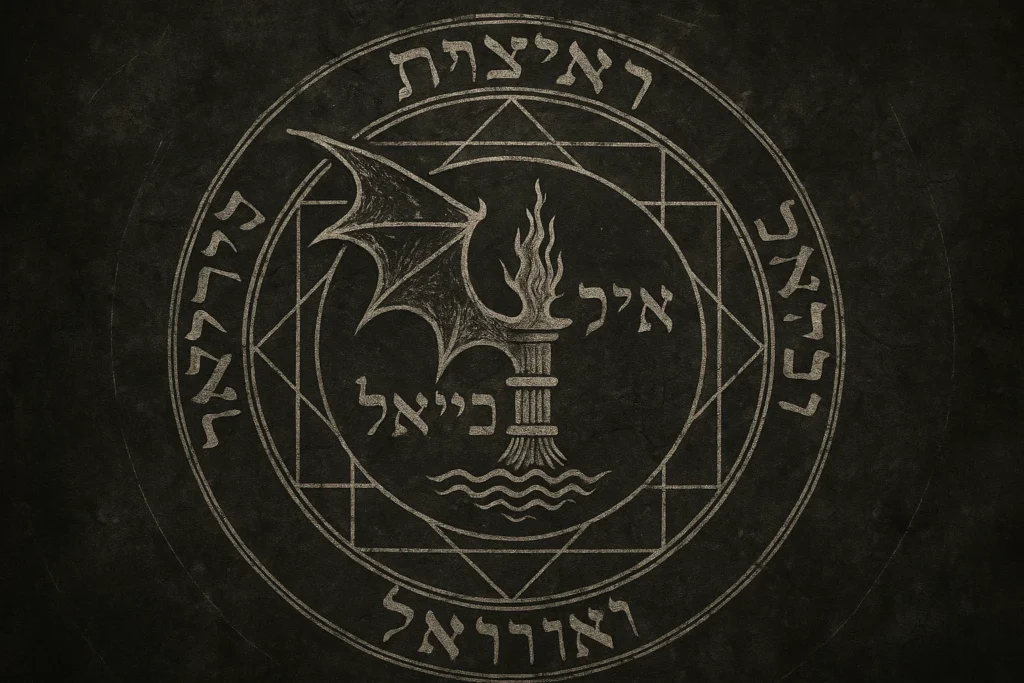
Associations
Abezethibou is associated with water’s deceptive calmness and is often depicted as being imprisoned within the pillars of the Red Sea.
Astrologically, Abezethibou is linked to Scorpio, influenced by the planets Mars and Pluto, which contribute to his transformative and venomous qualities. His ability to exploit elemental forces often serves as a temptation: the winds of the sea drive ambitions, while the abyssal depths hold onto grudges.
Numerologically, Abezethibou is associated with 12 servitors, which mirror the cycles of the zodiac, and the presence of 7 princes suggests the completeness of sin.
His thematic colors—blood-red and black—serve as tools for occult practitioners, who may invoke his cunning deceptions.
Zodiac and Astrological Links
Abezethibou is associated with the sign of Scorpio (and the month of October to November), symbolized by the scorpion, which is ruled by Mars, signifying aggressive action, and Pluto, representing deep psychological exploration.
Scorpio’s fixed nature reflects Abezethibou’s pride— a trait that has contributed to his ambitions and his rebellions against divine order, especially noted in his conflicts with angelic beings like Uriel. Additionally, Pluto’s transformative power relates to his role as a warden in Hell, where cycles of destruction and renewal operate through malicious intent. Horary astrology indicates that his influence peaks during Scorpio moons, making these times suitable for spells either of deception or rebellion.
Elements
Abezethibou is primarily associated with the element of water, which reflects his connection to the Red Sea and symbolizes his prison-like throne. He possesses the ability to summon floods or control water currents, highlighting a duality where freedom is both a lure and a trap for others, much like the fate of the Egyptian chariots.
In grimoires, the flow of water is noted to counterbalance his winds, intensifying emotional manipulations that can drown rational thought. Water’s adaptability reflects its transformation from a heavenly seraph to an abyssal guardian.
Colors, Numbers, and Crystals
Abezethibou’s color symbolism is dominated by blood-red, representing rage and loss, making it ideal for rites centered on envy and betrayal. This hue evokes the imagery of ichor spilled from celestial wounds, symbolizing tragic falls and unending fury, and is often utilized in talismans intended to channel hardening influences. Black is another significant color, reflecting the voids of Hell and serving well for invisibility spells or materials that bind the soul.
His numerological significance includes the number 12, symbolizing the cyclical nature of sin; the solitary 1, representing isolated pride; and the number 7, which connects to the structured completeness of evil in Hell.
Crystals associated with him include red jasper and bloodstone, both of which symbolize his ichor and are utilized in talismans for enhancing resolve. Obsidian offers insights into its abyssal nature but can shatter under holy light, indicating vulnerabilities. Rubies amplify anger, aligning with Mars and aiding in combat-related incantations, while bloodstone serves to mimic the consumption of essence. Black tourmaline provides grounding and protection against negative repercussions during rites.
Other Correspondences
In terms of metals, iron is significant for its binding qualities, symbolizing strength and resilience, and is often utilized in sigils that capture grudges. Copper represents malice and conducts deceptive energies, linking back to Abezethibou’s Egyptian roots.
Herbs such as nightshade, known for their toxic properties, can mislead individuals, making them useful in brews for divination purposes, potentially leading to malice. Mandrake, a powerful yet dangerous herb, is also referenced for its magical properties and should be used with caution.
Animals that symbolize Abezethibou include scorpions, representing stinging betrayal, and one-winged ravens, which are considered omens of misfortune. Flies, which are reminiscent of Beelzebub, highlight his connection to swarms and their potential to aid in deceptive pursuits.
Abezethibou’s Sigil and Symbols
Abezethibou‘s sigil (although absent from classic Goetia seals) is sometimes used in modern occult adaptations as a jagged glyph: a central crimson wing arched over wavy lines evoking the Red Sea pillars, bisected by an arc of a torn feather. Crossed by thorny vines symbolizing pride’s barbs, it curls into an abyss-hook, pulling downward like Tartarus’ maws.
Historically, Solomonic evokers sketched it on vellum with blood-mixed inks, placing it in circles to focus his windy summons—without steps, just intent to bind his boasts. Asymmetrical design mirrors his one-winged form, with swirling abyssal patterns representing watery prison and wind control.
Symbols extend to the solitary wing, red as arterial spill, etched on amulets to ward his influences or invoke for magic’s edge. The pillar of water stands emblematic, a vertical torrent cradling chains, referenced in Byzantine talismans against Egyptian curses—dipped in salt to mimic his prison.
In grimoires like Black Witch Coven’s, his seal incorporates scorpion tails for Scorpio sting, used in night altars to channel heart-hardening whispers.
You may also enjoy:
Who Is Jann in Islamic Mythology and Why Is He Feared?
October 2, 2025
Who Was Ravana in Hindu Mythology and Why Was He Feared?
October 3, 2025
Ifrit: Demon of Fire Who Serves Iblis in Islamic Tradition
September 30, 2025
Who Are the Yaksha, and Why Did Buddhists Fear Their Wrath?
October 20, 2025
Who Is Agaliarept, the General of Hell Under Lucifer?
October 8, 2025
Abadir: The Demon Servant of Chaos and Dispersion
September 30, 2025
